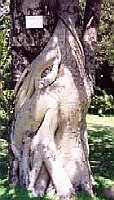| DESCRIPTION: It is an evergreen tree 6-21 m, with a rounded to spreading and dense crown. Sometimes epiphytic, often a strangler, trunk fluted or multistemmed. Bark smooth and grey on older branches and stems, lenticellate, often with aerial roots hanging down from branches. Leaves simple, glossy, dark green, 3-20 x 1.5-10 cm. Figs 7-14 mm in diameter. USE: A good jam can be made from the ripe fruits. Figs and especially leaves can be used as fodder. Wood is used as fuel, latex and fibre are extracted from the bark. The bark is important in local medicine, and it is used in treating colds, sore throat, dysentery, wounds, constipation, nosebleed and to stimulate lactation. Latex is used for wound fever, while an infusion of the root and fibre is taken orally to help prevent abortion. Powdered root is taken in porridge to stop nosebleed; the milky latex is dropped into the eye to treat cataracts. It is planted for erosion control, shelter and as an ornamental. This tree has an aggressive root system and should not be planted in a small garden or near buildings, swimming pools or paths. It makes an ideal shade tree in a large garden or park, and it makes a successful container plant for the patio. It is also ideal for use as a bonsai specimen. In Uganda, the tree is intercropped with coffee and bananas. Leaf litter helps in the improvement of the nutrient status and water-holding capacity of the soil. GROWING PERIOD: Perennial. COMMON NAMES: strangler fig. FURTHER INF: It is widely distributed in upland forest, open grassland, riverine and rocky areas and sometimes in savannah. Trees are relatively drought resistant. It occurs on a wide variety of soils but favours light, deep and well-drained soils with neutral to acidic reaction and humus-rich or deep loamy soil. |
